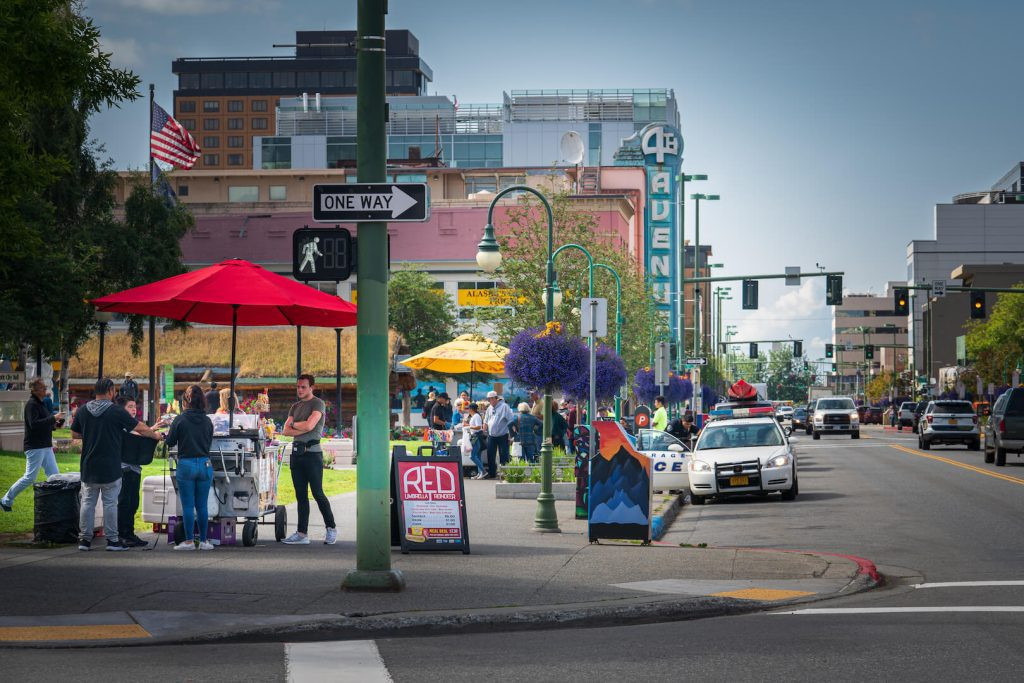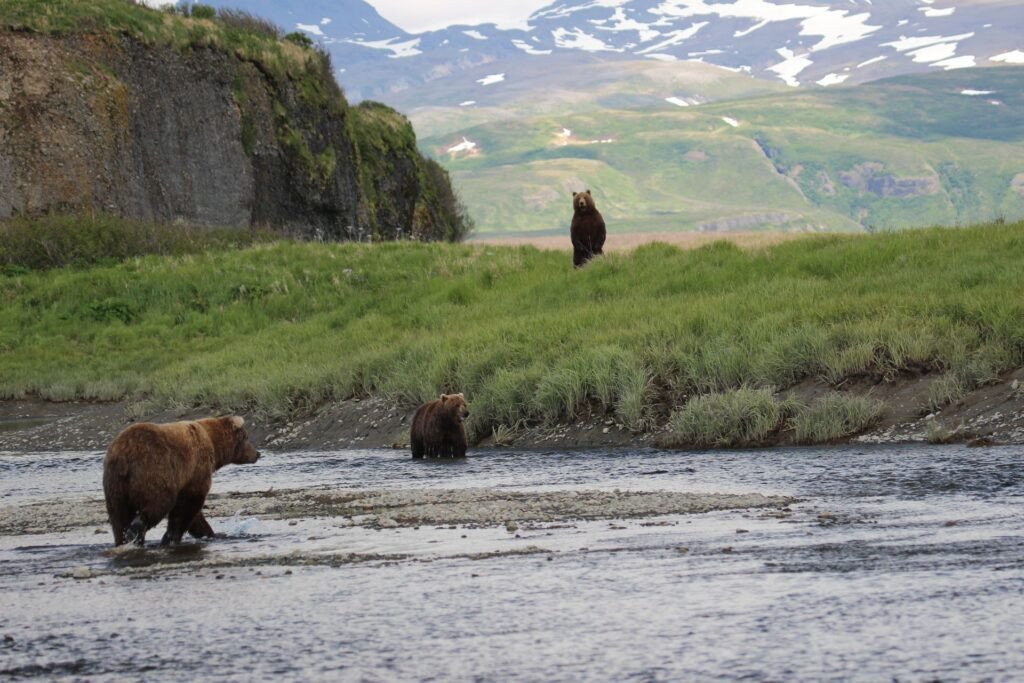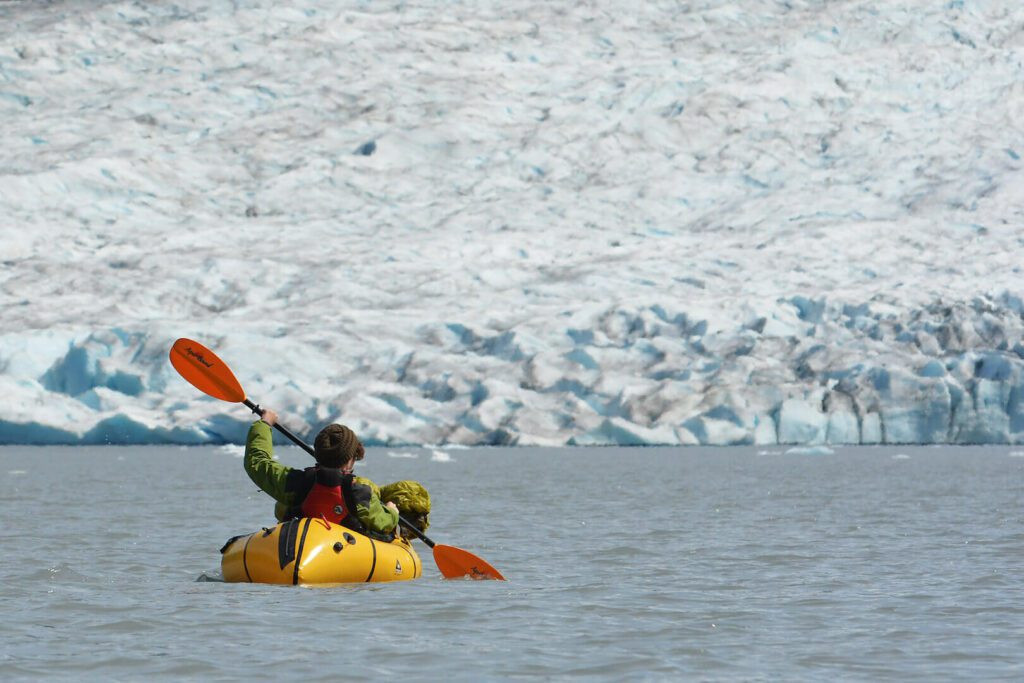Is It Safe To Travel To Alaska? Absolutely, Alaska is generally a very safe destination for tourists. SIXT.VN is here to provide a comprehensive guide to ensure your Alaskan adventure is both unforgettable and secure, with expert tips and resources for a worry-free trip. Discover the latest travel advisories, explore secure transportation options, and learn about emergency services to make informed decisions and enjoy the stunning landscapes of the Last Frontier.
1. Understanding Safety in Alaska’s Cities
Alaska’s urban centers, particularly Anchorage, are generally safe for tourists. Anchorage is the place where most Alaskan journeys begin, and it welcomes visitors with open arms. SIXT.VN ensures that your urban exploration is safe and enjoyable by providing local insights and secure transportation options.
1.1. Is Anchorage Safe for Tourists?
Yes, Anchorage is safe for tourists. Like any city approaching 300,000 residents, crime and homelessness exist. However, tourist areas are well-maintained and patrolled, such as Downtown Anchorage which is well-lit and frequently monitored, ensuring a safe environment for exploration.
1.2. Safety Tips for Exploring Alaskan Cities
- Stay Alert: Be aware of your surroundings, especially at night.
- Secure Belongings: Keep an eye on your valuables and avoid leaving them unattended.
- Well-Lit Areas: Stick to well-lit, populated streets.
- Local Guides: Consider booking tours with local guides for added safety and insider knowledge. According to research from the Alaska Travel Industry Association in 2023, guided tours enhance safety and provide a more enriching experience.
 Vibrant street scene with pedestrians, vendors, and cars on a sunny day, featuring colorful umbrellas and a clear signpost indicating Fourth Avenue in Anchorage, Alaska
Vibrant street scene with pedestrians, vendors, and cars on a sunny day, featuring colorful umbrellas and a clear signpost indicating Fourth Avenue in Anchorage, Alaska
1.3. How SIXT.VN Enhances Your Urban Safety
SIXT.VN offers reliable airport transfer services, ensuring you get to your accommodation safely and comfortably. SIXT.VN can help you arrange secure transportation options for exploring the city. With SIXT.VN, you can enjoy Anchorage with confidence, knowing your safety is a top priority.
2. Navigating Rural Alaska and Wildlife Safety
Venture into Alaska’s wilderness requires extra attention to safety. Rural Alaska offers breathtaking landscapes and unique wildlife encounters, but it’s essential to be prepared for the challenges of remote travel.
2.1. Is Rural Alaska Safe?
While crime rates are lower in rural areas, the remoteness and wildlife present different safety concerns. It’s important to be self-reliant and well-prepared when exploring the Alaskan wilderness.
2.2. How to Handle Wildlife Encounters
- Moose: Keep a safe distance, avoid sudden movements, and never get between a cow and her calf.
- Bears: Carry bear spray, make noise while hiking, and never run if you encounter a bear. According to the Alaska Department of Fish and Game, bear spray is highly effective in deterring bear attacks.
- Other Wildlife: Respect all wildlife and maintain a safe distance.
 Three brown bears near a river with a grassy landscape and snow-capped mountains in the background, spotted during a sightseeing tour in Alaska.
Three brown bears near a river with a grassy landscape and snow-capped mountains in the background, spotted during a sightseeing tour in Alaska.
2.3. Essential Gear for Wilderness Travel
- Navigation: Map and compass or GPS device
- Communication: Satellite phone or emergency beacon
- First Aid: Comprehensive first-aid kit
- Protection: Bear spray
- Essentials: Plenty of food and water, appropriate clothing
- Emergency Shelter: Emergency blanket or bivy sack
2.4. SIXT.VN’s Role in Your Wilderness Safety
SIXT.VN can arrange transportation to trailheads and remote locations, ensuring you start your adventure safely. SIXT.VN provides advice on essential gear and safety precautions, helping you prepare for the unique challenges of the Alaskan wilderness.
3. Understanding Alaska’s Unique Weather and Natural Hazards
Alaska’s weather is unpredictable, and natural hazards like avalanches and cold water pose safety risks. Be sure to know the risks, so you can prepare for them. Planning and the right equipment are essential for managing these challenges.
3.1. What are Alaska’s Weather Challenges?
- Rapid Changes: Weather conditions can change quickly and without warning.
- Temperature Extremes: Temperatures can range from warm to freezing, even in summer.
- Winter Storms: Snowstorms and icy conditions are common in winter. According to the National Weather Service, Alaska experiences some of the most extreme weather patterns in the United States.
3.2. How to Dress for Alaskan Weather
- Layers: Dress in layers to adjust to changing conditions.
- Waterproof Gear: Always carry a waterproof jacket and pants.
- Thermal Layers: Pack thermal layers for winter travel.
- Insulated Gear: Wear insulated boots, gloves, and a warm hat in winter.
3.3. Navigating Natural Hazards
- Avalanches: Check avalanche reports and avoid avalanche-prone areas.
- Cold Water: Wear a life jacket when boating or fishing, and be aware of cold water temperatures.
- Driving Conditions: Ensure your vehicle is equipped with winter tires, and check road conditions before driving.
 Packrafting at Spencer Glacier
Packrafting at Spencer Glacier
3.4. SIXT.VN’s Support for Weather Preparedness
SIXT.VN offers transportation services that take into account weather conditions, ensuring safe travel. SIXT.VN provides real-time updates on weather conditions and road closures, helping you make informed decisions.
4. Emergency Services and Contacts in Alaska
Knowing how to access emergency services in Alaska is crucial for a safe trip. Familiarize yourself with emergency contacts and procedures to ensure you can respond effectively in case of an emergency.
4.1. Key Emergency Contacts
- Emergency (Police, Fire, Ambulance): 911
- Alaska State Troopers: (907) 451-5100
- Alaska Poison Control: 1-800-222-1222
- Search and Rescue: Contact local authorities
4.2. How to Report an Emergency
- Stay Calm: Provide clear and concise information to the operator.
- Location: Clearly state your location and the nature of the emergency.
- Details: Provide as much detail as possible about the situation.
4.3. Accessing Medical Care in Alaska
- Hospitals: Major cities like Anchorage and Fairbanks have hospitals.
- Rural Clinics: Smaller towns have clinics, but services may be limited.
- Medevac Services: In remote areas, medevac services may be necessary for medical emergencies.
4.4. SIXT.VN’s Emergency Support
SIXT.VN provides 24/7 customer support to assist with emergencies. SIXT.VN offers assistance with contacting emergency services and arranging transportation to medical facilities.
5. Travel Advisories and Alerts for Alaska
Staying informed about travel advisories and alerts is essential for planning a safe trip to Alaska. Monitor official sources for the latest updates on potential risks and safety concerns.
5.1. Where to Find Travel Advisories
- U.S. Department of State: Check for travel advisories and alerts.
- Alaska Department of Health and Social Services: Monitor health advisories.
- Local News: Stay updated on local news for current events and safety concerns.
5.2. Understanding Alert Levels
- Advisory: Provides information about potential risks.
- Warning: Indicates a significant safety concern.
- Emergency: Signals an immediate threat to safety.
5.3. Responding to Travel Alerts
- Follow Instructions: Adhere to instructions from authorities.
- Adjust Plans: Modify your travel plans as necessary.
- Stay Informed: Continuously monitor updates from official sources.
5.4. SIXT.VN’s Commitment to Keeping You Informed
SIXT.VN provides timely updates on travel advisories and alerts, helping you make informed decisions. SIXT.VN assists with adjusting travel plans based on current safety concerns, ensuring your trip remains safe and enjoyable.
6. Safe Transportation Options in Alaska
Choosing safe transportation options is crucial for navigating Alaska’s diverse terrain. Whether you’re driving, flying, or using local transport, understanding the risks and precautions can enhance your safety.
6.1. Driving in Alaska
- Winter Driving: Use winter tires and drive cautiously on icy roads.
- Road Conditions: Check road conditions before setting out.
- Wildlife: Be aware of wildlife crossing roads, especially at dawn and dusk.
6.2. Flying in Alaska
- Bush Planes: Many remote areas are accessible only by bush plane. Choose reputable air services and follow safety guidelines.
- Weather Conditions: Flights can be affected by weather. Stay informed about potential delays or cancellations.
6.3. Local Transportation
- Taxis and Ride-Sharing: Use reputable taxi services or ride-sharing apps in urban areas.
- Public Transportation: Follow safety guidelines when using public transportation.
6.4. SIXT.VN’s Transportation Solutions
SIXT.VN offers reliable car rental services with vehicles equipped for Alaskan conditions. SIXT.VN can arrange airport transfers and transportation to remote locations, ensuring your safety and comfort.
7. Essential Safety Tips for Solo Travelers in Alaska
Traveling alone in Alaska can be an empowering experience, but it requires extra vigilance. Follow these safety tips to ensure a secure and enjoyable solo adventure.
7.1. Planning and Preparation
- Share Itinerary: Inform someone of your travel plans and expected return date.
- Emergency Contacts: Keep a list of emergency contacts readily available.
- Check In Regularly: Check in with someone regularly to update them on your progress.
7.2. Staying Safe on Trails
- Stick to Marked Trails: Avoid venturing off designated trails.
- Carry Communication Devices: Bring a satellite phone or emergency beacon.
- Be Aware of Wildlife: Make noise while hiking and carry bear spray.
7.3. Staying Safe in Towns and Cities
- Avoid Isolated Areas: Stay in well-lit and populated areas.
- Secure Accommodation: Choose reputable accommodation with good security measures.
- Trust Your Instincts: If a situation feels unsafe, remove yourself immediately.
7.4. SIXT.VN’s Support for Solo Travelers
SIXT.VN provides safe and reliable transportation options for solo travelers. SIXT.VN offers 24/7 customer support and assistance with emergency situations.
8. Health and Medical Safety in Alaska
Ensuring your health and medical safety is paramount when traveling to Alaska. Access to healthcare can be limited in remote areas, so preparation is key.
8.1. Vaccinations and Health Precautions
- Consult Your Doctor: Discuss necessary vaccinations and health precautions with your doctor before traveling.
- Travel Insurance: Ensure you have adequate travel insurance that covers medical emergencies.
- Medications: Bring any necessary medications and prescriptions.
8.2. Common Health Risks
- Hypothermia: Be prepared for cold weather and dress in layers.
- Altitude Sickness: If traveling to high-altitude areas, take precautions to avoid altitude sickness.
- Insect Bites: Use insect repellent to avoid mosquito and tick bites.
8.3. Accessing Medical Care
- Hospitals and Clinics: Major cities have hospitals and clinics.
- Medevac Services: In remote areas, medevac services may be necessary for medical emergencies.
8.4. SIXT.VN’s Health and Safety Resources
SIXT.VN provides information on local medical facilities and emergency services. SIXT.VN can assist with arranging transportation to medical facilities if needed.
9. Cultural Sensitivity and Respect in Alaska
Respecting local cultures and traditions is essential for a positive travel experience in Alaska. Understanding and appreciating the customs of Alaska’s diverse communities enhances your journey.
9.1. Understanding Alaska’s Cultures
- Indigenous Cultures: Learn about the traditions and customs of Alaska’s Indigenous peoples.
- Local Customs: Be aware of local customs and etiquette.
- Respect for Nature: Show respect for the environment and wildlife.
9.2. Interacting with Local Communities
- Ask Permission: Always ask permission before taking photos of people or entering private property.
- Support Local Businesses: Patronize local businesses and support the local economy.
- Be Respectful: Treat local residents with respect and courtesy.
9.3. Cultural Events and Festivals
- Attend Local Events: Participate in local events and festivals to learn about Alaska’s cultures.
- Learn the Language: Learn a few basic phrases in local languages.
9.4. SIXT.VN’s Commitment to Cultural Sensitivity
SIXT.VN promotes cultural sensitivity and respect through our services and interactions. SIXT.VN provides information on local customs and traditions, helping you engage respectfully with Alaska’s communities.
10. Booking Safe and Reliable Tours with SIXT.VN
Ensure your Alaskan adventure is both safe and memorable by booking tours through SIXT.VN. With a focus on safety, expert local guides, and meticulously planned itineraries, SIXT.VN provides peace of mind and unforgettable experiences.
10.1. Why Choose SIXT.VN Tours?
- Safety First: Tours are designed with your safety as the top priority.
- Expert Guides: Knowledgeable local guides enhance your experience and ensure your well-being.
- Reliable Transportation: Safe and comfortable transportation to and from tour locations.
- Customer Support: 24/7 customer support for any questions or concerns.
10.2. Popular SIXT.VN Tours in Alaska
- Anchorage City Tour: Explore Anchorage’s highlights with a guided tour.
- Wildlife Viewing Tour: See Alaska’s iconic wildlife in their natural habitat.
- Glacier Cruise: Experience the stunning beauty of Alaska’s glaciers.
- Cultural Tour: Learn about Alaska’s Indigenous cultures and traditions.
10.3. How to Book a Tour with SIXT.VN
- Visit Our Website: Browse available tours on SIXT.VN.
- Select Your Tour: Choose the tour that best fits your interests and schedule.
- Book Online: Securely book your tour online.
- Confirm Details: Receive a confirmation email with all the details of your tour.
10.4. SIXT.VN’s Promise of a Safe and Memorable Adventure
SIXT.VN is committed to providing safe, reliable, and unforgettable experiences in Alaska. With expert local guides, carefully planned itineraries, and a focus on your safety, SIXT.VN ensures your Alaskan adventure is everything you’ve dreamed of.
FAQ: Is It Safe to Travel to Alaska?
1. Is Alaska generally safe for tourists?
Yes, Alaska is generally safe for tourists, with most areas frequented by visitors being well-maintained and patrolled. However, like any destination, it’s important to stay aware of your surroundings and take basic safety precautions.
2. What are the main safety concerns in Alaska?
The main safety concerns in Alaska include wildlife encounters, unpredictable weather, natural hazards like avalanches, and remoteness, which can limit access to emergency services.
3. How can I stay safe from wildlife in Alaska?
To stay safe from wildlife in Alaska, keep a safe distance from animals, carry bear spray, make noise while hiking, and never approach or feed wildlife. Store food properly and be aware of your surroundings.
4. What should I do if I encounter a bear in Alaska?
If you encounter a bear in Alaska, do not run. Make yourself as large as possible, make noise, and slowly back away while facing the bear. If the bear charges, use bear spray and stand your ground.
5. How can I prepare for Alaska’s unpredictable weather?
To prepare for Alaska’s unpredictable weather, dress in layers, carry waterproof gear, check weather forecasts regularly, and be prepared for sudden changes in temperature and conditions.
6. What should I pack for a trip to Alaska?
Essential items to pack for a trip to Alaska include thermal layers, waterproof gear, insulated boots, gloves, a warm hat, a map, a compass or GPS device, a first-aid kit, and bear spray.
7. Are there any travel advisories I should be aware of for Alaska?
Check the U.S. Department of State website for travel advisories and alerts. Also, monitor local news and the Alaska Department of Health and Social Services for health advisories.
8. How can SIXT.VN help ensure my safety in Alaska?
SIXT.VN offers reliable transportation services, real-time updates on weather conditions, assistance with emergency services, and carefully planned tours with expert local guides, all designed to enhance your safety and comfort.
9. Is it safe to travel solo in Alaska?
Traveling solo in Alaska can be safe if you take extra precautions. Share your itinerary with someone, check in regularly, stick to marked trails, carry communication devices, and be aware of your surroundings.
10. What should I do in case of a medical emergency in Alaska?
In case of a medical emergency in Alaska, dial 911 for immediate assistance. Major cities have hospitals, and smaller towns have clinics. Medevac services may be necessary in remote areas. Ensure you have adequate travel insurance.
Traveling to Alaska is an adventure of a lifetime, and SIXT.VN is dedicated to ensuring your journey is both safe and memorable. By providing reliable transportation, expert local guides, and comprehensive safety information, SIXT.VN empowers you to explore the Last Frontier with confidence.
Ready to embark on your Alaskan adventure? Contact SIXT.VN today to book your tours and transportation, and let us help you create an unforgettable and safe experience.
Address: 260 Cau Giay, Hanoi, Vietnam
Hotline/Whatsapp: +84 986 244 358
Website: SIXT.VN



